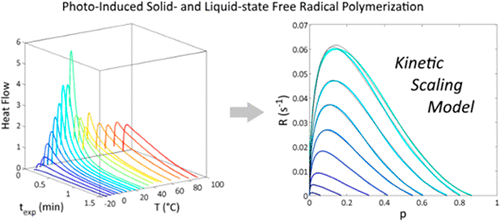当前位置:
X-MOL 学术
›
Macromolecules
›
论文详情
Our official English website, www.x-mol.net, welcomes your feedback! (Note: you will need to create a separate account there.)
A Semiempirical Scaling Model for the Solid- and Liquid-State Photopolymerization Kinetics of Semicrystalline Acrylated Oligomers
Macromolecules ( IF 5.5 ) Pub Date : 2018-07-03 00:00:00 , DOI: 10.1021/acs.macromol.8b00706 Patrice Roose 1 , Hugues Van den Bergen 1 , Annemie Houben 2 , Dirk Bontinck 1 , Sandra Van Vlierberghe 2
Macromolecules ( IF 5.5 ) Pub Date : 2018-07-03 00:00:00 , DOI: 10.1021/acs.macromol.8b00706 Patrice Roose 1 , Hugues Van den Bergen 1 , Annemie Houben 2 , Dirk Bontinck 1 , Sandra Van Vlierberghe 2
Affiliation

|
The recent introduction of semicrystalline acrylated oligomers exhibiting fast photoinitiated free radical polymerization in the solid state calls for a deeper understanding of the mechanisms behind the reaction kinetics. The photoinduced polymerization of an acrylated urethane-based poly(ethylene glycol) precursor was studied in detail at temperatures below the melting point using differential photocalorimetry. In isothermal conditions, the exothermal heat flow profile is characterized by an acceleration step followed by a gradual deceleration. In contrast to liquid-state photopolymerization, the well-known gel effect cannot be invoked to account for the reaction acceleration in the crystallized resin. By revisiting the kinetics of free-radical polymerization, it appears that the acceleration results from the buildup of the radical concentration toward steady state in a reaction–diffusion driven process. The kinetic behavior is examined in terms of conversion for which any structure-dependent kinetic effect is described by a power-law approximation based on scaling arguments from experimental evidence and polymer physics. This results in a closed-form analytical expression that compares well to experimental data for the photopolymerization kinetics of a semicrystalline acrylated urethane precursor upon adjustment of three parameters. The model is extended to include the additional kinetic complexity for liquid (meth)acrylates and provides a unified approach to free-radical polymerization built on fundamental insights.
中文翻译:

半结晶丙烯酸低聚物的固态和液态光聚合动力学的半经验缩放模型
最近引入的在固态下显示出快速光引发自由基聚合作用的半结晶丙烯酸酯化低聚物要求对反应动力学背后的机理有更深入的了解。使用差示量热法在低于熔点的温度下详细研究了丙烯酸酯化的氨基甲酸酯基聚(乙二醇)前体的光诱导聚合。在等温条件下,放热热流曲线的特征在于加速步骤,然后逐渐减速。与液态光聚合相反,不能调用众所周知的凝胶效应来解释结晶树脂中的反应加速。通过重新研究自由基聚合的动力学,看来,加速是由于在反应扩散驱动的过程中自由基浓度向稳态的累积所致。根据转化率检查了动力学行为,对于该结构,依赖于实验证据和聚合物物理学的定标参数,通过幂律近似来描述任何与结构有关的动力学效应。这导致了一个封闭形式的分析表达式,该表达式与三个参数调整后的半结晶丙烯酸酯化氨基甲酸酯前体的光聚合动力学实验数据完全吻合。该模型被扩展为包括液态(甲基)丙烯酸酯的额外动力学复杂性,并提供了基于基础知识的统一的自由基聚合方法。根据转化率检查了动力学行为,对于该结构,依赖于实验证据和聚合物物理学的定标参数,通过幂律近似来描述任何与结构有关的动力学效应。这导致了一个封闭形式的分析表达式,该表达式与三个参数调整后的半结晶丙烯酸酯化氨基甲酸酯前体的光聚合动力学实验数据完全吻合。该模型被扩展为包括液态(甲基)丙烯酸酯的额外动力学复杂性,并提供了基于基础知识的统一的自由基聚合方法。根据转化率检查了动力学行为,对于该结构,依赖于实验证据和聚合物物理学的定标参数,通过幂律近似来描述任何与结构有关的动力学效应。这导致了一个封闭形式的分析表达式,该表达式与三个参数调整后的半结晶丙烯酸酯化氨基甲酸酯前体的光聚合动力学实验数据完全吻合。该模型被扩展为包括液态(甲基)丙烯酸酯的额外动力学复杂性,并提供了基于基础知识的统一的自由基聚合方法。这导致了一个封闭形式的分析表达式,该表达式与三个参数调整后的半结晶丙烯酸酯化氨基甲酸酯前体的光聚合动力学实验数据完全吻合。该模型被扩展为包括液态(甲基)丙烯酸酯的额外动力学复杂性,并提供了基于基础知识的统一的自由基聚合方法。这导致了一个封闭形式的分析表达式,该表达式与三个参数调整后的半结晶丙烯酸酯化氨基甲酸酯前体的光聚合动力学实验数据完全吻合。该模型被扩展为包括液态(甲基)丙烯酸酯的额外动力学复杂性,并提供了基于基础知识的统一的自由基聚合方法。
更新日期:2018-07-03
中文翻译:

半结晶丙烯酸低聚物的固态和液态光聚合动力学的半经验缩放模型
最近引入的在固态下显示出快速光引发自由基聚合作用的半结晶丙烯酸酯化低聚物要求对反应动力学背后的机理有更深入的了解。使用差示量热法在低于熔点的温度下详细研究了丙烯酸酯化的氨基甲酸酯基聚(乙二醇)前体的光诱导聚合。在等温条件下,放热热流曲线的特征在于加速步骤,然后逐渐减速。与液态光聚合相反,不能调用众所周知的凝胶效应来解释结晶树脂中的反应加速。通过重新研究自由基聚合的动力学,看来,加速是由于在反应扩散驱动的过程中自由基浓度向稳态的累积所致。根据转化率检查了动力学行为,对于该结构,依赖于实验证据和聚合物物理学的定标参数,通过幂律近似来描述任何与结构有关的动力学效应。这导致了一个封闭形式的分析表达式,该表达式与三个参数调整后的半结晶丙烯酸酯化氨基甲酸酯前体的光聚合动力学实验数据完全吻合。该模型被扩展为包括液态(甲基)丙烯酸酯的额外动力学复杂性,并提供了基于基础知识的统一的自由基聚合方法。根据转化率检查了动力学行为,对于该结构,依赖于实验证据和聚合物物理学的定标参数,通过幂律近似来描述任何与结构有关的动力学效应。这导致了一个封闭形式的分析表达式,该表达式与三个参数调整后的半结晶丙烯酸酯化氨基甲酸酯前体的光聚合动力学实验数据完全吻合。该模型被扩展为包括液态(甲基)丙烯酸酯的额外动力学复杂性,并提供了基于基础知识的统一的自由基聚合方法。根据转化率检查了动力学行为,对于该结构,依赖于实验证据和聚合物物理学的定标参数,通过幂律近似来描述任何与结构有关的动力学效应。这导致了一个封闭形式的分析表达式,该表达式与三个参数调整后的半结晶丙烯酸酯化氨基甲酸酯前体的光聚合动力学实验数据完全吻合。该模型被扩展为包括液态(甲基)丙烯酸酯的额外动力学复杂性,并提供了基于基础知识的统一的自由基聚合方法。这导致了一个封闭形式的分析表达式,该表达式与三个参数调整后的半结晶丙烯酸酯化氨基甲酸酯前体的光聚合动力学实验数据完全吻合。该模型被扩展为包括液态(甲基)丙烯酸酯的额外动力学复杂性,并提供了基于基础知识的统一的自由基聚合方法。这导致了一个封闭形式的分析表达式,该表达式与三个参数调整后的半结晶丙烯酸酯化氨基甲酸酯前体的光聚合动力学实验数据完全吻合。该模型被扩展为包括液态(甲基)丙烯酸酯的额外动力学复杂性,并提供了基于基础知识的统一的自由基聚合方法。



























 京公网安备 11010802027423号
京公网安备 11010802027423号